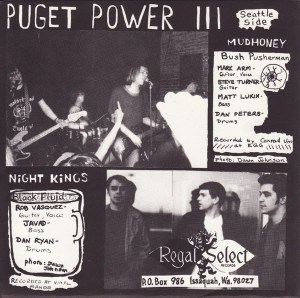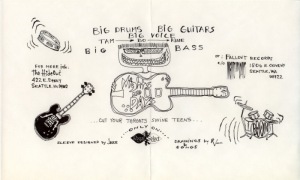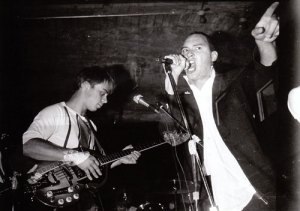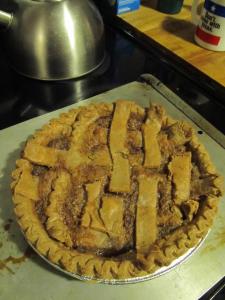Before there was Ty Segall,Nobunny or Fe Fi Fo Fums, there were the second wave garage bands from the so-called early ’90s revival. With the exception of Detroit’s Gories, Billy Childish’s Thee Headcoats and Memphis’ Oblivians, some of the best stripped-down, dirty guitar bands from that era came from the West Coast: The Mummies, Supercharger, The Fall-Outs, Girl Trouble. And one of the most incredible of them all came out of Seattle. Not even one band, actually, since none of his ten or so bands ever lasted very long, but a guitarist with a beat up Fender amp and a classic graveyard howl: Rob Vasquez.
Kinks-type riffs, thunder drums, fast changes – Vasquez delivered the whole raw, gutter-cocktailwith his earlier bands the Nights and Days and Night Kings, all the frantic yet melodic boom, bap, boom that fans of The Stooges and MC5 want in their music. The terrible essence of these bands can be summarized with one of the most tired lines in music: how can someone who writes such amazing songs remain so tragically underappreciated? Even in Vasquez’s native Pacific Northwest, and in our era of file-sharing and music blogs, it’s shocking how few people know the guy’s name.
Vasquez started playing in Seattle around 1976 with a punk band called The Feelings. According to the book Loser, they were one of the first bands in Seattle “to get into the snarly, surly attitude rock being spread in England by the Sex Pistols and the Damned. Its songs included ‘Turds of Love.’ Guitarist-singer Greg Ragan used to hang from curtains and rafters and scream his lyrics while writhing about. At one Odd Fellows [Hall] show, Ragan went into convulsions during the set and crawled to a restroom to vomit while drummer Dean Helgeson tore up his rented kit.”
When The Feelings split up, Vasquez started another band called The Look, followed by Egor, then Nights and Days, then Night Kings, Ape Lost, The Chintz Devils, Gorls, Man Tee Mans, Right On, currently Nice Smile, and in his wake he left a string of stellar 45s. Some of them, like the Gorls’ split 7-inch with the band Flathead, are quiet classics, but it’s his Night Kings and Nights and Days stuff that won him diehard fans. In Jay Hinman’s ’90s Superdope zine #5, Vasquez says the difference between these two bands is that “The Nights & Days were kind of mod-garage kind of stuff, style and music, whereas Night Kings I think are a little more of a punk offering than the Nights & Days were.” That’s as detailed a quote as you’re likely to find from him, because few fanzines, let alone glossy magazines, ever bothered to interview him. Named for the Fabulous Wailers’ song “All My Nights, All My Days,” the Nights and Days put out three 45s and some songs on a few compilations. One, called “Split,” appears on the famous 1988 Sub Pop 200 comp. Another, called “These Days,” has a chorus and melody so catchy that it always struck me as some sort of anthem. Same can be said for the more melancholic “Goes Without Saying.” Night Kings put out three 45s, two split 7’s and one LP, called Increasing Our High. It’s the sole full-length in Vasquez’s thirty-six-or-so years of playing. It came out on the Super Electro label, was never issued on CD, and it’s been the out of print since the early ’90s.
Mudhoney’s Steve Turner – one of the musicians who put Seattle on the map – started Super Electro in 1992. Turner was a Vasquez fan. In the liner notes to Mudhoney’s March to Fuzz anthology, Turner describes the influences you hear in their song “Touch Me I’m Sick:” “In retrospect,” he says, “it’s The Yardbirds’ ‘Happenings Ten Years Time Ago’ by way of The Stooges’ ‘Sick of You’. At the time I was trying for the stuttering R&B guitar of The Nights and Days.” Until Super Electro ceased operation seven years later, the label released 45s and LPs from Seattle bands such as The Kent 3, Wellwater Conspiracy, The Statics and The Fall-Outs, as well non-Northwest musicians such as Thee Headcoats, Holly Golightly and The Masonics. Although some might argue that The Kent 3 is the most underappreciated Seattle band of all time, many garage rock types would say that the Night Kings’ LP is the true cream of Super Electro’s crop.
Released in 1992 in the midst of the grunge feeding frenzy, Increasing Our High bears only the faintest whiffs of that era. The best songs sound as timeless as the bands that seem to have inspired Vasquez, such as The Kinks and The Sonics. The Pacific Northwest had always been a hotbed of garage music, but at that time, a so-called neo-garage revival was sweeping through the global music underworld. The charge was initially led by The Gories, and although the revival spawned tons of cookie-cutter, backward-looking bands with pageboy haircuts and formulaic tunes, it also birthed now legendary bands such as The Mummies, The Trashwomen and Supercharger, bands who turned the vintage sound into something completely unique and far more inventive than simple retro posturing. It’s with the Gories and Mummies that Vasquez’s Night Kings most closely fit, albeit still loosely. Despite his obvious influences, Vasquez wasn’t drawing from the all too familiar Nuggets and Pebbles wells to scavenge paisleysounds to meticulously recreate. He was someone for whom ’60s rock riffs best fit his fury. His Night Kings songs “Black Fluid,” “Dirty Work,” “Death,” “Black and White,” “Bum” and“Complaint Dept” are frenzied, infectiously catchy,and, despite their relative simplicity, have tons more personality than most of the songs that derivative garage dress-up bands such as The Fuzztones and The Lyres produced. If Vasquez’s anger and punk root-stock weren’t enough to earn his music wide recognition, then at least these elements colored his music with enough originality to distinguish it from the garage revival pack.
Listening to Increasing Our High, your feet tap and head sways, and when the gravely lyrics rise above the distorted guitar, you start to wonder: what’s this guy so angry about? Everything. He’s pissed about money, pissed about rules. He’s pissed about women and power, peoples’ perceptions and what the world expects from him. He works shitty jobs (“Dirty Work”) for low pay and he’s mad about it, though not mad enough to quit drinking so much beer and sitting around stoned watching TV (“Bum”) to pursue a better line of work. Yet beyond the particular sources of his ire, lies an indiscriminate, almost adolescent rage. Vasquez is just pissed, period, one of those fiery guys who might have been born with a chip on their shoulder and who give you the finger simply because they can.
Whatever the source of his energy, Vasquez’s sole LP seems destined to remain in that fetishized subset of the underground rock canon where the “underappreciated classics” go, and not simply based on the power of his songwriting, but also on the album’s limited availability. Apparently, an early ’90s Illinois-based fanzine called Bad Vibe was going to release a Nights and Days LP, but that didn’t pan out. They might have discovered what so many people in Seattle, including promoters, record labels, musicians, even Vasquez’s own band members, already knew: that he was difficult, some said impossible, to deal with. He’s been called “a dick.” On the Right On record sleeve, he seems to acknowledge his reputation when he credits his role in the band as “Guitar and His Big Mouth.” In the end, this makes Steve Turner the only person to squeeze a whole album out of Vasquez. The rest of Vasquez’s music scattered across a slew of 7-inches with print runs ranging from 250 to 1000. Based strictly on the size-to-convenience ratio, Increasing Our High offers the ideal starting point for anyone interested in checking out this aging punk’s music. Based on the unfiltered force of the performances, though, I would suggest tracking down each 45. They’re essentially live recordings, and they are full of The Stooge’s raw power. Yes, tracking them all down will require some hunting and shipping and handling fees, and you still won’t be able to play the songs on your iPod until you digitally transfer them yourself,but most of the records are readily available for purchase online. The best takes of some of Increasing Our High’ songs appear on their respective 45s, all recorded during different sessions: “Bum” on the Bum/Ain’t No Fun 45, “Death” from the Brainwashed EP, and “Dirty Work” from the Tales from Estrus Vol. 1 compilation. The one track that doesn’t appear on the LP but which is worth hunting down no matter what is “Black Fluid,” from the Puget Power III 45 (Regal Select Records). If you like rock and roll enough to have read this far, then that song will colonize your brainstem like root rot and never let go.It’s one of the best garage-punk songs of not only the ’90s, but any era.
The lyrics go:
First thing’s a double in the morning
When that one’s gone another’s coming
It goes on and on for hours
Untill I think I’ve got the power
Power climbing up the walls and grinding down
I can’t sit still, can’t hang around
My blood’s not red anymore
Black fluid oozing out my pores
One cause of Vasquez’s relative obscurity lies not in the quality of his music, but in its limited availability: maybe 90% of his recorded output, from thirty-six-plus years of playing, has never appeared on CD, only vinyl. And except for his new band’s, Nice Smile’s, 2010 seven-inch single, Building/Mans To Short, all of that vinyl is out of print. No iTunes downloads, no last.fm or Bandcamp sampling. You can’t even find that Nice Smile record at Silver Platters, Sonic Boom or Everyday Music in Seattle. I tried. Vasquez and the band aren’t in the stores’ databases. When I called each store in the summer of 2011, I listed a few of his other bands in hopes of sparking some faint recollection. Each clerk responded with a variation of the same reply: No, never heard of him. “Usually in these cases,” the clerk at Sonic Boom said, “I direct people to the artist’s website.” That’s another problem.
Nice Smile’s Myspace page is so Spartan and sporadically updated that it hardly qualifies as a web presence. Where the first thing most bands do nowadays is start a Bandcamp and Facebook page, seed certain music blogs with sample tracks, and sell their songs online, Vasquez’s music seems as inaccessible as it was in the pre-mp3 era. The issue of its invisibility is less the result of a disinterested public and more the result of his apathetic approach to self-promotion. From Gorls to The Chintz Devils to Right On, he’s never heavily promoted any of his bands.
I did some cyber-sleuthing last summer and managed to dig up Vasquez’s email address. His attitude might best be summarized by what he wrote me in an email: “shows, eh, nothin really planned out. not really aggressive about that kinda stuff, so we dont really play out much.” His small but dedicated group of fans hails him as an underground artist, and he is in the sense that he’s never been on a major label, never played outside the West Coast, and he drew many of his own record sleeves. But if he’s underground in the cool, respectable, punk rock sense of the term, it’s not because mainstream America has continually ignored his advances. He’s underground because he doesn’t make his music or himself that available. In our era of social-networking and transparent self-promotion, most people know that audiences don’t come to you. You have to get music into people’s hands, play out and blanket the web to let them know you exist. This is particularly regrettable since Nice Smile songs such as “My World,” “Dark Thud” and “The Show,” as with much of Vasquez’s previous music, are too powerful to let wallow away on some Myspace page’s embedded player, unavailable for purchase. It’s not like people aren’t interested.
Europeans sell his 45s on Discogs for up to 20+ Euros a pop. On music blogs such as Detailed Twang, guys describe the Nights and Days’ Garbage Can single as “one of the great records of the 80s to boot, and an all-time second-wave-of-garage landmark.” On message boards such as Terminal Boredom, fans write gushing accounts of Vasquez’s talent like “The live Right On stuff he used to have up on the MySpace page for his former page for his former bands just SLAYS – too bad that’ll never see the light of day,” and they trade and sell records: “Need a Nice Smile 7”! Have a spare Ape Lost.” The Hospitals’ guitarist and singer, Adam Stonehouse, credits Vasquez as his primary inspiration for playing music. When The Gories played Seattle in September, 2010, their second guitarist Dan Kroha wore a Night Kings shirt. “I often tell people that if we’d heard ‘Garbage Can,’ the Gories would never have formed,” Mick Collins told me over Twitter, “that’s what we wanted to sound like.” Even the Seattle Weekly gave a brief but resounding nod in their 2008 “Grunge 101” article: “Seattle might not know it, but Rob Vasquez is a goddamn rock-and-roll genius: His ’80s band, the Nights and Days, were hugely underrated, and his turn-of-the-decade band, the Night Kings, were just as good. The Night Kings played garage rock (not grunge at all) minus any and all lame revival shtick.” Imagine how many more people would share that enthusiasm if they could only find his music. Although some people might view Vasquez’s indifference as part of his punk rock mythos or DIY aesthetic, for me, it’s difficult not to see it as the most unfortunate thing a musician of his ability can do to themselves: not get heard.
Hopefully, this might be changing a little. In the summer of 2010, Nice Smile opened for the legendary Gories on a short West Coast tour from Seattle to San Diego. They released the aforementioned 45. In 2008 they included a song on Funhouse Comp Thing II, a double CD put out by the longtime Seattle club The Funhouse. Vasquez told me he wants to eventually record a Nice Smile LP. Other than that, they still don’t have any local shows booked, and their Myspace page lists no news of upcoming releases. As Vasquez put it in an email: “you gotta realize were kinda bums at this whole mess. but ya, we’ll get some wax out again but we have no label and ive never fished.”
Unlike Rob’s previous efforts, Nice Smile is a duo. Interestingly, it’s The Statics’ first drummer, Donnie Hilstad, who now plays in it. He also played drums on Gorls’ two releases, Bongo Beat and the Tracie 45. Besides the two-piece format, what also distinguishes the band is Donnie’s drumming. One part Philly Joe Jones, one part Russell Quan, he stomps out big beats, crashes cymbals and pounds the floor-tom, conjuring a thunderstorm when the mood calls for it. But he also has a jazz drummer’s sensibility, that flexible, intuitive sense of timing, as well as quick snare rolls and gentle taps of the ride. That lighter touch perfectly fits the moody shifts and soft bridges of the song “The Show” (an old Chintz Devils tune). And it adds a distinctive texture to the loose, dark, almost deconstructivist “Muse” and “Mans To Short” (a revived Pissed Off Zombies song), giving Nice Smile a different, varied flavor than the more rocking four-four and punk beat Night Kings.
Judging from his new music, Vasquez seems to have mellowed a bit. One thing that has not changed is Vasquez’s signature guitar tone and playing. You’d recognize it anywhere. Dave Crider of Estrus Records once called it “shit-o-phonic,” a description Rob dislikes. RV’s gravely, tortured howl is still intact too, still front-and-center. One of the things that’s so interesting about listening to Nice Smile is that, no matter how “modern” some of it is, most of it still sounds like Night Kings and Nights and Days. When the opening riff of “The Show” kicks in, it sounds like it could have been written by 1988 or 1992 Vasquez. Same with guitar on “My World” and “Dark Thud.” That’s because Rob builds his songs from timeless materials. Straight rock and roll does not age. Beneath the sonic adulterations of effects pedals, keyboards and buried, echoey Sic Alps type mixes — all of which I love — melody and mood also matter. Vasquez has always delivered those. If his new songs could be mistaken for “old” songs, it’s not because they’ve aged poorly or feel out of sync with the so-called times; it’s because they’re vintage. Timeless. As evergreen as “Strychnine.” Nice Smile proves that Vasquez hasn’t failed to evolve; he’s simply stayed true to his favorite sound, which is, at its heart — whether under the name garage, under whatever name you want — the sound of pure rock and roll.
All of which is to say, hopefully we’ll get a Nice Smile LP soon.
There are apparently a bunch of unissued songs lying around. Someone in Germany was supposed to, or may still be planning to, release some lost Night Kings tunes on a Night Kings compilation. Vasquez’s short-lived band The Pissed Off Zombies recorded an album’s worth of songs; the kick ass Bay Area record label Hook or Crook was going to release it but, for some reason, it fell through. There’s still that unreleased Nights and Days LP, and that live soundboard Right On recording, and there’s all those incredible Nice Smile songs on Myspace. Rob and Donnie made what he called a short “cheap mic set up” recording at rehearsal last summer that he was going to send me, but Rob ultimately wasn’t happy with the sound. In 2007, the band was selling two different CD-Rs at Seattle Nice Smile shows, simple homemade things with hand-written covers. It’s the closest thing to a Nice Smile album that exists. I’ve never been able to track down copies.
Clearly the time has come for a Vasquez retrospective. Unfortunately, if he’s as difficult to deal with as some people say, then the only person able to release such a compilation might be Vasquez himself.
On September 6, 2011, Mark Yarm published the book Everybody Loves Our Town: An Oral History of Grunge. I read it and loved it, and it left me thinking about my ’90s youth, the music that spilled out of old Seattle, and also, about Vasquez. I spun a bunch of his records and thought about how his music seemed to have so much potential for wider appreciation, if not on the scale of his Seattle contemporaries, then at least an appeal wide enough to have elevated him beyond the status of “tragically overlooked local legend.” But there are those musicians who just want to write music and be left alone. They enjoy the creative process for its own intrinsic rewards and don’t want to perform publically, or make money from their art, or even involve themselves in the commercial aspects of being in a band. You have to respect that. Touring, booking, dealing with club owners, record labels and royalties – from all reports, it sounds grating. Maybe Vasquez is that type of musician. Or maybe he was self-sabotaging. Maybe he just needed a little outside push to get him going, or maybe he pushed too many people away. It’s all speculation, yet the record is indisputable: during the early ’90s, while fellow Northwesterners such as Nirvana, Mudhoney and Soundgarden appeared on innumerable magazine covers, released albums on major labels and graduated to the large concert stages and world tours that defined their mid-90s careers, Vasquez remained in Seattle, playing the occasional local venue, pressing small runs of seven-inches, and working odd jobs. Which is where he remains today: as talented as ever, and just as invisible.
In 2010, Soundgarden reunited. Rolling Stone and Spin covered it. They played the Conan O’Brien Show.
In 2010, Nice Smile played Betsy’s Radar Hair and Records, a split salon and record store, in Seattle. No one wrote about it.
I’m writing this in the hope that others will hear him.
* * *
Bonus feature: Here’s some rare footage of Vasquez playing live. Although this is Vasquez’s band Nice Smile, they’re playing a Pissed Off Zombies song called “Garbage,” never officially released. Video shot 9/11/10 in Seattle at a club called Neumos, at the end of the Gories tour:
And here’s some more live footage of Nice Smile. They’re playing the song “Think You’re On Top of the World” by Vasquez’s band Right On, another song that was never officially released. This vid is composed of still photos from a January 15, 2011 show at Radar Hair and Records in Seattle:
Also, some DLs of 45s here and there, there and over here. No matter what you do, track down the Nights and Days’ song “These Days.”
And some info on rock and roll photographer Bob Kondrak.










